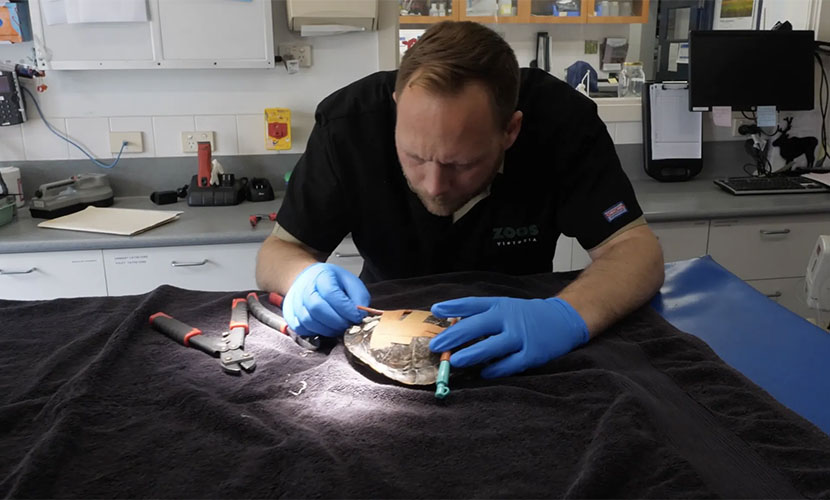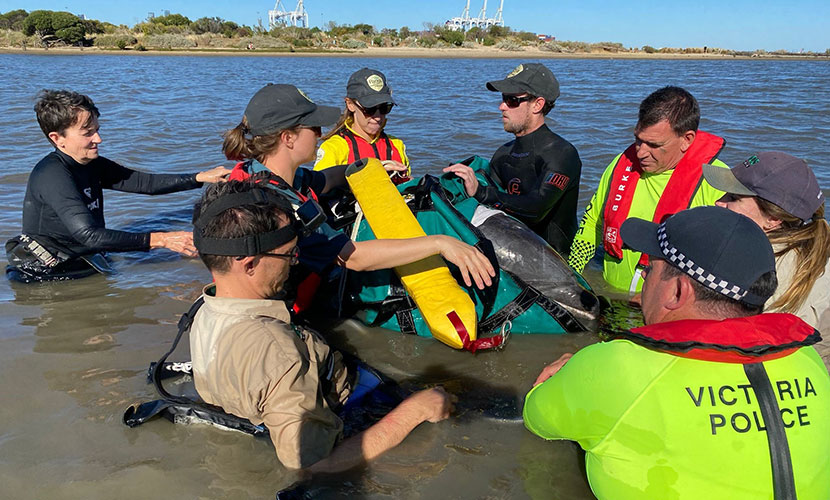Rescue success for zoo teams
It’s been a busy start to the year for Melbourne Zoo’s veterinary and wildlife rescue teams.
Vets at both Melbourne Zoo and Healesville Sanctuary are seeing an increase in the number of turtles needing treatment for serious injuries resulting from being struck by vehicles. The vets advise motorists to look out for the slow-moving reptiles and other wildlife on Victorian roads.
Melbourne Zoo veterinarian Dr Kate Bodley said there are more turtles, especially Eastern Long-necked Turtles, on Victoria’s roads at the moment because of an increase in breeding activity throughout summer and early autumn.
“Eastern Long-necked Turtles are frequently moving around and often end up on roads where they are susceptible to being hit by cars,” Dr Bodley said. “Because turtles are slow-moving, they can really get into trouble on roads.”
Healesville Sanctuary’s Australian Wildlife Health Centre sees between 30 and 40 of these cases every year. The Melbourne Zoo team recently spent several months treating and rehabilitating an Eastern Long-necked Turtle before releasing it back to its wild home.
The turtle was found by a member of the public laying injured on a road in Central Victoria and taken to a local veterinary clinic in Castlemaine before being transferred to Melbourne Zoo’s veterinary department for treatment.
After X-raying the aquatic animal and determining that it had not suffered any internal injuries, the Zoo’s vets worked to stabilise its shell. The shell fragments, connected with wires and a strong-hold putty, allowed it to heal, much like a fractured human bone.
“We manage a broken shell in the same way you would manage any other fracture,” Dr Bodley said. “We try to manage any movement in the fracture sites and keep the area clean and dry as the bones heal.”
The turtle was rehabilitated over ten weeks before being released back into a creek in Central Victoria.
Several other turtles treated at Healesville Sanctuary have been successfully rescued, rehabilitated and released.
Melbourne Zoo’s Marine Response Unit (MRU) was involved in several successful animal rescue and release missions this year, including releasing a dolphin that became stranded at Greenwich Bay in Williamstown last month. The dolphin had been foraging for fish in the shallow water but got caught in an outgoing low tide.
Melbourne Zoo Marine Response Unit Coordinator Mark Keenan said the animal flailed in the shallow water as it tried to free itself. “When we first arrived, the dolphin was essentially stuck in the mud,” Mr Keenan said. “It was thrashing to clear itself and its blowhole of the mud and water so that it could breathe.”
Together with Victoria’s Water Police, Parks Victoria, and officers from the Department of Environment, Land, Water and Planning, the Marine Response Unit placed the dolphin on a stretcher and then a boat to move it out to deeper water.
Mr Keenan said it took an incredible team effort to release the dolphin successfully.
“Sometimes dolphins are stranded because they’re sick,” Mr Keenan said. “In this case, it was a geographical stranding, so it meant that the animal was a lot stronger.
“It was a huge group effort. So many people came together to help. And it was wonderful to see a dolphin swim off into the distance and, seemingly, trying to catch fish upon its release.”
Last year, the MRU recorded the highest number of callouts in its eight-year history, responding to 918 cases over 12 months and representing a 40 per cent increase in the volume of incidents from the previous year.
Anyone who sees an injured turtle on the road is advised to take it to the local vet or one of the Zoos Victoria veterinary facilities at Melbourne Zoo, Werribee Open Range Zoo and Healesville Sanctuary.
Anyone who sees injured marine wildlife should call the Melbourne Zoo Marine Response Unit 1300 245 678 •

The Movement Refinery: 20 years and still going strong





 Download the Latest Edition
Download the Latest Edition